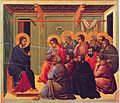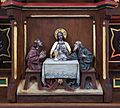Disciple (Christianity) facts for kids
In Christianity, a disciple is someone who learns from a teacher. The word comes from an old Greek word meaning "learner." In the Bible, disciples were the students and followers of Jesus during his time teaching people. Sometimes, this word refers only to the Twelve Apostles, but the Bible also talks about many other disciples.
It's important not to confuse a disciple with an apostle. A disciple is a student who learns. An apostle is someone who is sent out to share those teachings with others. So, all apostles were disciples first, but not all disciples became apostles. Today, people who follow Christian teachings often call themselves disciples, showing they want to keep learning from Jesus.
Contents
Jesus's First Followers
The First Four Disciples
The Bible tells us that Jesus first called four fishermen to follow him near the Sea of Galilee. These were Simon (who Jesus later called Peter, meaning "Rock") and his brother Andrew. The other two were brothers, James and John. Jesus called James and John the "Sons of Thunder." These four became very close to Jesus.
In some parts of the Bible, only Peter, James, and John are mentioned as being with Jesus during special moments. This is why they are sometimes called "the three."
The Twelve Apostles
Jesus chose a special group of twelve disciples to be his closest followers and to help him spread his message. These men are known as the Twelve Apostles. They were given special tasks and powers by Jesus.
Here are the names of the Twelve Apostles:
- Simon, also called Peter
- Andrew, Peter's brother
- James, son of Zebedee
- John, James's brother
- Philip
- Bartholomew (also called Nathanael)
- Matthew (also called Levi), who was a tax collector
- Thomas
- James, the son of Alphaeus
- Simon, sometimes called "the Zealot"
- Judas Iscariot, who later betrayed Jesus
- Jude Thaddaeus (also called Thaddaeus or Judas, brother of James)
After Jesus died and came back to life, Paul also became an apostle, even though he had not followed Jesus during his life.
One of Jesus's disciples is often called "the one whom Jesus loved" in the Gospel of John. Many people believe this was John, because he is not named directly in that book, unlike the other apostles.
Many More Disciples
Jesus had many more followers than just the twelve. The Bible mentions a large crowd of people who listened to his teachings.
There was also a group of seventy (or seventy-two) disciples that Jesus sent out in pairs. They went ahead of him to different towns to prepare the way. They were told to heal the sick, share the good news about God's kingdom, and tell people that listening to them was like listening to Jesus himself. They were given special powers and were told that their names were written in heaven.
The Road to Emmaus
After Jesus came back to life, he appeared to two of his disciples on the road to a town called Emmaus. One of them was named Cleopas, and the other is not named. They were walking and talking about all the things that had happened in Jerusalem. A stranger joined them, and they didn't recognize him as Jesus.
Later, when they stopped for a meal, the stranger blessed and broke the bread. At that moment, they realized it was Jesus! Then he disappeared. Cleopas and his friend quickly went back to Jerusalem to tell the other disciples the amazing news.
Women Disciples
Women also played an important role as disciples of Jesus. The Bible mentions several women who followed Jesus and supported him and his disciples.
- Mary, the sister of Lazarus, was known for sitting and listening carefully to Jesus's teachings. Her sister, Martha, was often busy with household tasks, but Mary chose to focus on Jesus's words.
- Mary Magdalene is one of the most well-known female disciples. She traveled with Jesus and the twelve apostles. She was also one of the first people to see Jesus after he came back to life and was among the women who went to his tomb.
- Joanna, the wife of Herod's steward Chuza, and Susanna are also named as women who helped support Jesus and his followers with their own money.
Many other women were also present at important events, like the crucifixion (when Jesus died on the cross) and the resurrection (when he came back to life).
Related pages
- Baptism
- Great Commission, which tells disciples to teach all nations
- Pillars of the Church
Images for kids
See also
 In Spanish: Discípulo (cristianismo) para niños
In Spanish: Discípulo (cristianismo) para niños



